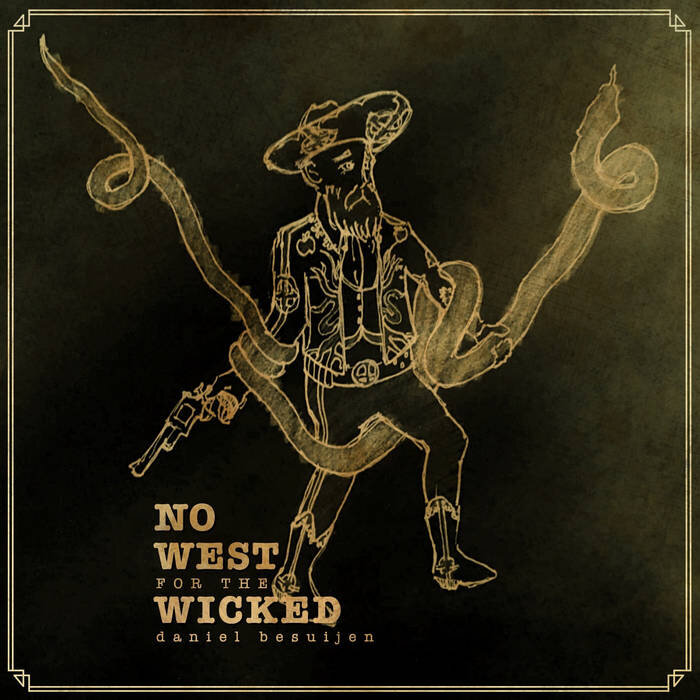Daniel Besuijen/Evan Shay
Daniel Besuijen
No West for the Wicked // GVG Records
Having released albums of psych, prog, electro-pop and more with Robot Hive, The Venus Extraction, Yama Hama, and on solo outings, country music seemed to be the only genre Daniel Besuijen didn’t have on his resume, so naturally, he has risen to the challenge and released No West For The Wicked. This album’s genre du jour may come as a surprise to fans of Besuijen’s previous material, but the album never feels like a novelty project. It feels like Dan has always had this album in him, and he has finally decided to bring out the whiskey and let the songs out.
In the first few songs of NWFTW Besuijen proves that he’s more than capable of crafting classic country tunes, even if it means handling most of the instrumental duties himself. Former bandmates Paul Hutchinson and Matt Kaip add some drums and electric guitar respectively, but everything else from the slide guitar to the keyboards is all Dan. During his time in various bands Besuijen has taken on numerous roles ranging from background shoegazin’ noisemaker to the lead singer afloat in a sea of keyboards, and on this album he demonstrates an impeccable understanding of what each track needs. Sometimes a janglin’ acoustic with a root fifth bassline, boom chuck drums and a slippery slide guitar do the trick, like on “New Year Old Me,” but on “Nothing Compares,” the secret ingredient is saloon-ready piano that sits underneath the ethereal guitar to keep the song grounded as an encore that Lucky Day, Dusty Bottoms and Ned Nederlander could have played if “My Little Buttercup” had landed better in Three Amigos! Throughout the album there’s the ineffable feeling that the songsmith responsible for the tunes has spent time with other genres, and he’s using that education to inform his treatment of this latest batch. On “I’m Going Away,” Besuijen lets his other influences show a bit, and the result is a Floydian floater that sounds more like Arctic Monkeys than Johnny Cash, but the outlier gives the album more depth rather than making it feel disjointed. With this detour, and some of the hazy false starts placed at the beginning of songs, the listener is reminded that this may be a country album, but it’s coming from a guy who has been known to invite his audiences to shout out Radiohead requests in between his songs.
That Three Amigos! reference in the previous paragraph might have felt a little forced, but the 1986 cult classic starring Steve Martin, Chevy Chase and Martin Short informs Besuijen’s new country aesthetic from his tongue in cheek cowboy songs to his amigo garb featured on the cover art and in the music video for “Nothing Compares.” While far from the banjo-backed comedy of Steve Martin’s early records, this album features more humour than any of Besuijen’s previous work, and Dan’s newfound wit fits nicely. Besuijen starts the album off with an exaggerated yokel vocal followed by a ton of dog puns, and “Nothing Compares” is the best raunchy astronaut country one can find anywhere in the galaxy. The jokes are clever, and you likely won’t catch all of them on the first listen. Amidst the space country there are also the obligatory country lyric staples like horses, drinking and heartbreak. The album is dedicated to three departed friends, and even though Besuijen is generous with his witticisms, he bears his heart on his sleeve with the embroidery. Both sides are balanced nicely on “I Don’t Know,” which features silly dismissive lyrics about conspiracy theories and scripture before reflecting on personal missed opportunities and past mistakes. Besuijen’s ability to write from the head and the heart simultaneously gives the songs a refreshing depth.
On No West For The Wicked, Daniel Besuijen pledges allegiance to country music with crossed fingers, and as he messes with the genre, he reminds us that country has its conventions, but pedal steel fit nicely on Dark Side of the Moon too. In 2020 lots of radio country has more in common with rock music than with the classics, and guys like Orville Peck and Sturgil Simpson are stretching the genre’s definition by peppering in bits of shoegaze, psych, blues and indie rock. With his new record, Besuijen displays a love of classic outlaw country while still letting other genres inform the approach to making a multifaceted album.
- Devon Dozlaw
Evan Shay
New Normal // Independent
Evan Shay’s new release, New Normal, is an apocalyptic and eclectic ode to the 1971 film Vanishing Point alongside “the intense months of the pandemic” and “the fear and rage at witnessing the rise of fascism in the United States”. Wailing, desolate saxophone soars over racing drums. Ambient synths drone alongside rhythmic basslines. Evan Shay breeds loneliness and fear into something grandiose and modern, a brooding catharsis.
Based in Montreal, Evan Shay has been making music as a saxophonist for a while, but this is his first solo project. Before his foray into this project and production, he played with Lawful Citizen, which released the last project Shay worked on, Internal Combustion: “a gritty fusion of guitar and metal-influenced compositions”. With New Normal, Evan Shay blends his saxophone playing with the diverse tools that are unlocked by producing an album as well as playing on it. He employs, as opposed to a focus on guitar and metal, a focus on a very different set of genres, from Electronic, to Hip-Hop, to Ambient and Jazz.
New Normal begins with “Light” featuring Kyle Hutchins, a droning instrumental overture that sets the tone with ominous rattling and an introduction to Evan Shay’s saxophone. The album develops slowly as Shay laces in racing drums and looming instrumentation that builds over the first half of the project from apocalyptic and sparse to minimalistic and relaxed. New Normal gives a sense of otherworldly panic devolving into boredom and existential unease which, as we all know, makes for an alright Hip-Hop track: “Smoke” featuring HPRIZM and Kyle Hutchins evokes Captain Murphy and more mainstream Hip-Hop production while Evan Shay riffs ominously on his sax in the background. “Chillin” and “Unlearn”, the next two tracks, could almost be lifted off of New Normal and dropped into any number of mainstream projects, the horns slip into jazzy from ambient and the drums are decidedly relaxed and fun, vocals come through clearly with minimal effects. The context of the album, however, turns these tracks from Jazzy Hip-Hop into a relieving break, a moment above water. In “Scale”, we are plunged back into the atmosphere that Evan Shay builds in the first half of the album, distorted acapella vocals and noisy instrumentation reminds us where we are and what we’re living. New Normal ends in a flurry, the tone of the last two tracks, “Empty” and “New Normal”, are sad, lonely, accustomed, relaxed, frenzied, and angry all at once. Evan Shay’s resolution is not a finale, it’s a trailing off, an unfinished story with no certain ending.
Evan Shay’s first solo project, New Normal, is everything all at once: a trap that many producers fall into, but one that Evan Shay turns into an inspiration. In an attempt to reflect a complex and horrifying reality with the depth it deserves, Evan Shay has constructed with New Normal a sound and story that is complex, unique in its approach to music and genre, and - most importantly - enjoyable.
- Devon Acuña


